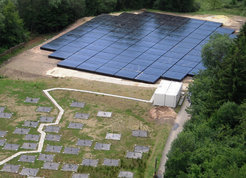Finger on the pulse of the pulsars
European LOFAR telescope provides the most sensitive observation to date at low frequency
An international team of astronomers including German scientists has succeeded in recording the most sensitive observations to date of pulsars at low frequency. The measurement was undertaken with the European LOFAR radio telescope network. Pulsars are fast-rotating neutron stars that are formed in the explosion of very massive stars (supernovae).

“The imaging methods with LOFAR differ greatly from those of conventional radio telescopes,” says Ralf-Jürgen Dettmar from the Ruhr University of Bochum and Chairman of the German GLOW consortium. “With conventional systems, only quite small areas of the sky can be covered in a short time. LOFAR, on the other hand, makes it possible to take snapshots of vast regions of the sky in the same time, and thus enables us to monitor these regions to discover new pulsars and possibly other rare phenomena.”
For the next stages in the investigation of pulsars the research team wants to use the special abilities of this radio telescope to get on the trail of the radiation mechanism of the neutron stars. “LOFAR is a fantastic telescope to complement our current observation instruments to study pulsars at long wavelengths,” says Max Planck Director Michael Kramer. The system has the potential to find a large number of previously undiscovered pulsars in the vicinity of our sun. “We want to use them to detect gravitational waves.”
LOFAR enables scientists to investigate radio waves across a very extensive frequency range – across more than one order of magnitude from 10 to 240 megahertz. Apart from searching for pulsars, the system is used for sky surveys in the long-wave radio range, and also for cosmological studies, as well as to monitor solar activity and study planets. LOFAR additionally acts as the forerunner project for the Square Kilometre Array (SKA), the planned global radio telescope of the next generation.
(HOR / NJ)
Glossary
LOFAR
The International LOFAR Telescope (ILT) was designed mainly by ASTRON, the Dutch Institute for Radio Astronomy, in collaboration with a number of international partners. Four of the five German LOFAR stations are now in operation. The station in Effelsberg is operated by the Max Planck Institute for Radio Astronomy, the station in Unterweilenbach by the Max Planck Institute for Astrophysics, the station in Tautenburg by the Federal State Observatory of Thuringia, and the station in Bornim by the Astrophysical Institute Potsdam. The German LOFAR partners have teamed up to form GLOW, the German Long Wavelength Consortium. The international LOFAR telescope will ultimately consist of at least 36 individual stations in the Netherlands and eight stations in Germany, France, Great Britain and Sweden. Germany is the most important international partner. Each station consists of hundreds of dipole antennas that are electronically networked to form a huge radio telescope, with an area half the size of Europe.
GLOW
GLOW is the German consortium for the measurement of long radio waves. Its Chairman is Ralf-Jürgen Dettmar (Ruhr University of Bochum), the Deputy Marcus Brüggen (Jacobs University of Bremen). The members of the consortium are the astronomical institutes of the universities in Bielefeld, Bochum, Bonn and Cologne, the Max Planck Institute for Radio Astronomy in Bonn, Jacobs University in Bremen, the Max Planck Institute for Astrophysics and the Universe Cluster of Excellence in Garching, Hamburg Observatory, Jülich Research Centre, the Astrophysical Institute Potsdam and the Federal State Observatory of Thuringia in Tautenburg. The joint aims are to set up and coordinate the German LOFAR network and the associated science network, and to support the education and training of students.
